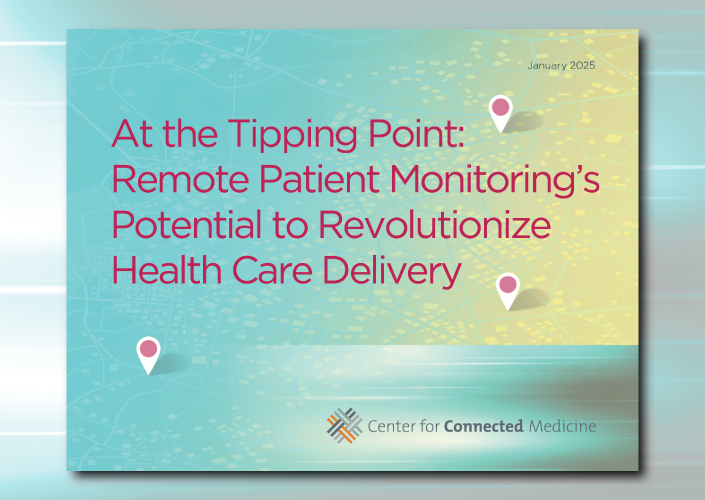UPMC Vice President Katie Scott explains the importance of providing a quality digital patient experience
Note: This executive response was produced prior to the Covid-19 pandemic, which accelerated the demand for digital health services and focused greater attention on digital tools at health systems. Telemedicine usage at UPMC skyrocketed during March and April 2020 and the health system rolled out new digital features, including online scheduling for video visits on its mobile app. Read more about digital solutions at UPMC here.
Providing digital health tools for patients to self-manage their care is no longer a “nice to have,” it’s a necessity. Today’s consumerism has caught up to health care, and health systems that continue to lag in more-modern offerings risk losing patients to those that do — within a region and increasingly outside of it.

“It’s gone from digital health tools being a satisfier when they exist, to being a dissatisfier when they don’t,” explained Katie Scott, Vice President of Digital Strategy and Innovation for UPMC Enterprises. “Institutions such as banks and retail are already doing this, and health care came late to the party.”
A recent survey from the Center for Connected Medicine (CCM) and HIMSS Media indicates health care leaders understand this new mandate. Three-quarters of 136 IT, business, and clinical stakeholders surveyed in September 2019 had deployed at least one digital health tool to patients.
Those tools most often allow patients to access medical records, make appointments, manage payments, and search for doctors.
However, only one-third believed their current offerings were on par with the best possible consumer experience.
This disparity between select investments and perceived value does not surprise Scott.
“There are a lot of legacy infrastructure and systems that health systems are dealing with,” she said. “Banks had to overcome these challenges in the last five to 10 years. And there is a lot of complexity and security in health care that’s similar to banking, which makes building a tool that the patient sees difficult.”
Scott believes a bigger issue may be in how these digital health tools tend to be introduced as point solutions rather than as part of a more cohesive consumer experience.
“We provide digital options for only specific parts of the care journey — such as patients discovering they can access digital tools pre-surgery, but after surgery, they are back to the phone and paperwork,” she said.
That continued reliance on an analog approach also limits use cases, value, and immediate return on investment from those digital tools that are adopted, Scott added.
Care access among biggest drivers
Surveyed health organizations’ biggest driver for adopting digital health solutions was improving patients’ access to care (51%). That goal was followed by 41% wanting to improve monitoring and management of chronic conditions and to achieve higher patient satisfaction scores.
The greatest growth, they believe, initially will come from monitoring and managing chronic conditions and from modern check-in management.
Those priorities make sense to Scott, who also sees the check-in experience as a great place to launch a patient facing digital program. “It’s a nice handoff between what you can do at home and what we can do in the clinic,” she said.
Barriers to mass adoption
Six in 10 survey respondents cited the cost to build, buy, and maintain a digital health tool as their top challenge. Respondents from smaller providers also were more likely to encounter lower patient or clinician interest in new digital tools.
About one-half (54%) had yet to see significant operational savings from going digital. As Scott tells it: The technology is not the hard part; it’s the organizational and operational change that often requires transformation as well.
The convenience and accessibility patients now want require health organizations to also change how they conduct business and deliver care.
“If on-demand telemedicine is going to change how patients contact their primary care provider for same-day appointments, we need to be ready to provide that,” she said.
UPMC, a leading integrated delivery and financing system, is making such a shift. The health system’s leadership decided almost two years ago to focus resources from its existing web-based patient portal, a robust-yet-underutilized system, to a simpler, patient-friendly mobile application with smaller feature sets such as accessing test results, messaging physicians, and finding care.
Since launching the mobile app in late 2018, UPMC is averaging 250,000 mobile users a month, with an average age of 40, who are far more active than registered users for the web-based patient portal. “They keep coming back because it’s more convenient and it’s easier to use,” Scott said. “That’s where everybody is now, and we finally met them there.”
Scott warns that those who fail to adopt patient-facing digital health tools soon risk losing patients from not only regional competitors but also the national telemedicine providers, which provide care through telemedicine and telehealth. “Patients expect us to do things digitally now,” she said. “And if we can’t, they will look for someone who can.”



